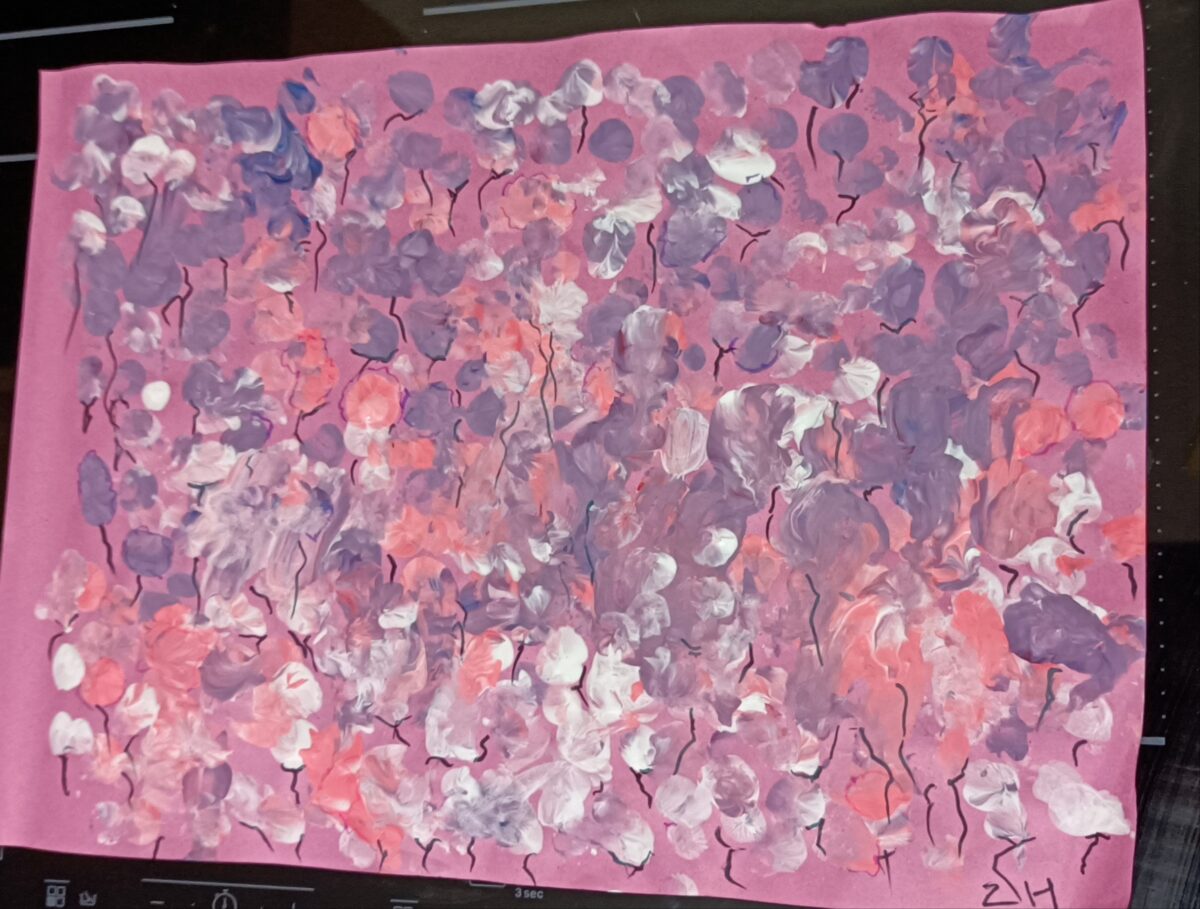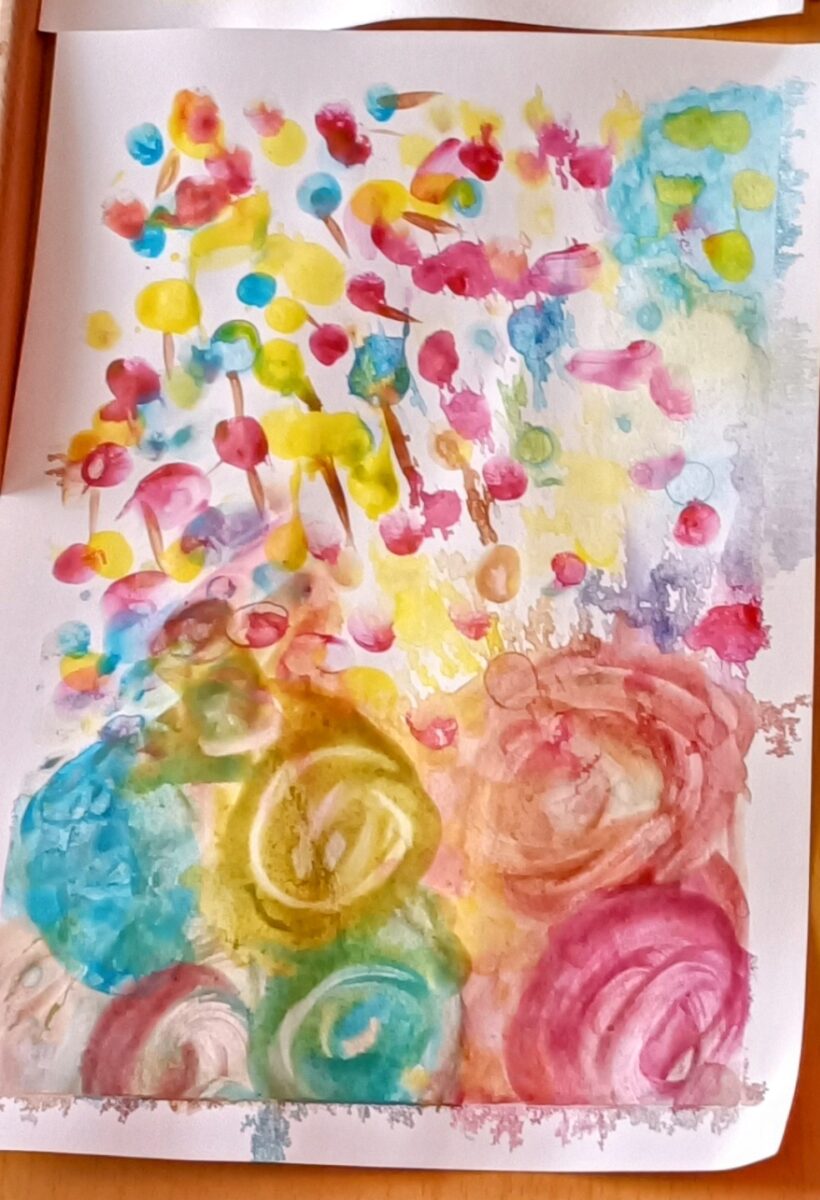Finger painting might not be the first thing you think of when you’re planning an activity for someone with dementia. It wasn’t for me either, at first. But over time, I realised just how calming and absorbing it could be. You don’t need a lot of instructions or fine motor skills, just some paint, a surface, and a willingness to get a little messy.

It’s one of those activities where there’s no wrong way to do it. That really mattered when my mum was having days where words were hard or following steps felt overwhelming. The feel of paint on your fingers, the movement, the colours, it all seemed to settle her in a way few other things did. Art really did become a major part of our lives.
I ended up putting together a finger painting kit we could grab whenever we had one of those restless afternoons or needed a shift in energy. It wasn’t fancy, but it worked. And once it was all together in one place, it made starting easier too. Here’s how I set ours up and what I’d include if I were doing it again.
Start with the surface
Not everyone likes the same thing. I found it helped to try a few different surfaces and see what felt right. Mum sometimes preferred the feel of paper—especially if I taped it down so it wouldn’t move about.

If you’re starting from scratch, I’d suggest having a mix of options. Thick card or watercolour paper holds the paint better and doesn’t tear as easily. A laminated sheet or even the back of a cereal box can work if you want something sturdier. I also tried dark backgrounds a few times, like navy or black card, which made the colours pop more or like above on coloured paper like this pink/peach colour. That worked well on days when lighter colours were harder for Mum to see.
You could even use paper plates or fabric scraps if you’re up for experimenting. Textured surfaces added a nice variety, especially later on when Mum didn’t always want to paint on plain paper.
Pick paints that are simple and safe
I stuck to non-toxic, washable paints—usually the sort made for toddlers. I didn’t want to worry about what would happen if it got on clothes or if Mum brought her hands to her mouth, which she often did.
For some peace of mind, I sometimes mixed a bit of yoghurt with food colouring when she was in a phase of exploring everything with her mouth. It didn’t look as bold, but it did the job and meant I didn’t have to hover anxiously the whole time.
A basic set of primary colours was more than enough. We mixed them now and again, but mostly we kept things simple. On a good day, Mum would pick the colours herself. On quieter days, I’d just put out two or three and let her choose.
I also added in a few soft brushes, cotton wool balls, and makeup sponges. They were a good fallback when she wasn’t keen on using her fingers but still wanted to take part.
Set it all up in one place
I used a shallow plastic box with a lid—nothing fancy. The aim was to make the whole thing easy to grab without thinking too much. I kept everything in there: paper, paints, sponges, a painting bib and a little towel.
We’d set up at the over the chair desk (which had a handy pop up lift up part that worked as an easel). I kept a bowl of warm water and a flannel nearby for cleaning hands for really messy days, or simple baby wipes worked, which helped when Mum started to feel uncomfortable with too much mess.
The biggest help was not over-preparing. I didn’t set it out like a craft project. I’d just say, “Fancy doing some painting for a bit?” and go from there. No pressure, no big setup.
Try some light themes if the mood fits
Sometimes, having a theme made it easier to get started. Around Easter, we did soft pastels and egg shapes. In autumn, we used orange and brown and did blobby leaf-like prints with our fingers. Nothing precise, just colours and shapes that made sense in the moment.
We also used seasonal stencils to dab paint on to that made things easier.
That said, I wouldn’t worry too much about making it ‘seasonal’. Some days, red, yellow, and blue splodges were more than enough.

Adapt it as things change
In the early stages, Mum liked having choices. As things changed, I focused more on the sensory side. The feeling of paint on her skin, the smoothness of the card, the warmth of the water to clean her hands, those details started to matter more than the finished piece.
I noticed that when words got harder, painting gave her something else, a kind of non-verbal way to express herself. It wasn’t always clear what the picture was meant to be, but it didn’t need to be. We just did it together, quietly, and that was enough.
Encouraging Social Interaction
If you’re caring for someone at a later stage of dementia, this kind of open-ended, sensory activity can still be really meaningful. And if they’re having a hard day and don’t want to join in, it’s okay. I’d sometimes start painting on my own and wait, more often than not, Mum would join in when she was ready.
Even if your loved one doesn’t say much during the activity, the shared moment still matters. I didn’t always see it straight away, but afterwards, there was often a kind of calm that settled in.
For more ideas like this, try these from visual art activities for late-stage dementia.
If you’d find it helpful, I’ve also put together a simple “How to make a Finger Painting Kit for Dementia Care” printable checklist of what to include in the kit – you can download it here and keep it somewhere handy.
Final thoughts
Making up a finger painting kit isn’t about creating a big, fancy project. It’s about giving yourself one less thing to think about on the days when nothing else is landing. Having it all in one box meant I didn’t need to plan or scramble. I could just reach for it, set it out, and we were doing something.
It became part of my caregiver toolkit, something simple, tactile, and open-ended that worked whether Mum was chatty or quiet, tired or restless. Some days we painted a lot, some days not at all. But I was always glad we had it ready, just in case.


